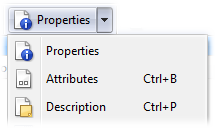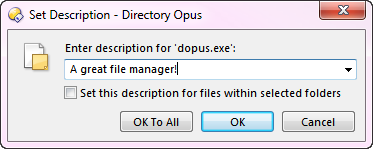File Descriptions
File Descriptions are a user-defined string that can be assigned to a file or
folder, often used to keep notes about the file contents. Unfortunately Windows
does not provide a standardised system for adding a user-defined description to
files and folders. Opus does allow you to do this, and provides two different
mechanisms for storing these descriptions:
- The descript.ion system is an old, pseudo-standard,
that saves all the descriptions for the items in a folder to a separate
file (called "descript.ion") in the same folder. You can enable support for
this system using the option on the Folders / Folder Behaviour page
in Preferences.
- The NTFS comments system uses the Alternate Data Stream feature of the NTFS file system to
store the description for a file in a separate data stream attached to the
file.
Each of these two systems have their own advantages and disadvantages. The
descript.ion system may be supported by other programs - for example,
some image viewing tools support it, and you may want to enable this in Opus so
that descriptions added by one program can be seen in the other. The
disadvantages of descript.ion are that it is less efficient - every
time a description is read or written, the descript.ion file has to be
opened and parsed. The descript.ion files can also clutter up your file
listings, although Opus does give you the ability to hide them if desired.
Using the NTFS comments system is more efficient than
descript.ion and as alternate data streams are not normally visible, it
can give a more elegant and unified feel to using file comments. The main
disadvantage is that they are only supported on NTFS-formatted drives - if
you're using another file system like FAT32, this system doesn't work.
Whichever system you elect to use, you can assign a description to a file in
two ways:
- Using the Description command in the
Properties drop-down on the default toolbar.

You can also press
Ctrl+P. This displays the Set Description dialog, which
displays the current description (if any) and lets you clear or edit
it.

The Set this description
for files within selected folders switch causes the function to
operate recursively - all files inside any selected folders will be given the
same description.
- Using the Metadata Pane
or the Set Metadata
dialog. These let you edit the description for selected files using the
Comment field in the Extended Properties
category.

See the Editing Metadata page for more information on
using the metadata editor.
By default Opus does not preserve file descriptions when you copy a file, as
(particularly when using descript.ion) this can slow down the file copy
process. The Preserve the descriptions of copied files option
on the File
Operations / Copy Attributes page in Preferences lets you enable
this if desired.


